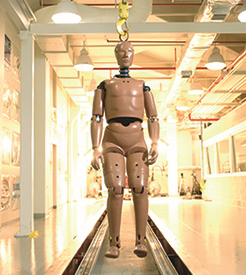Title
Computational Consideration of Crush Energy Estimation in Frontal Collisions with Underride and Lateral Offset
Document Type
Technical Paper
Publication Date
4-16-2012
Publication Title
SAE International
Abstract
The use of stiffness coefficients is a well-established method for estimating the crush energy of passenger vehicles involved in frontal impact. This methodology, as well as other crush energy models, have been adapted to take into account laterally offset frontal impacts. On the other hand, methods for estimating crush energy and/or Equivalent Barrier Speed (EBS) of frontal underride collisions (vertical offset) require more development. Further, there is a need for crush energy estimation models for cases of combined lateral and vertical offset impacts as well. The objective of this research is to computationally explore the effect of lateral offset, as well as combined lateral and vertical offset on the crush energy absorption of a car in a frontal collision and the feasibility of a generalized stiffness-coefficient-based EBS approximation approach.
The finite element model of a 1990 Ford Taurus, which was improved in previously published research, was further validated against seven full-frontal crash tests. For the purpose of this work, the validation scope was limited to the relation between crush energy and residual crush. A 50%lateral offset impact into a deformable barrier was also analyzed for crush energy and was compared to the full-frontal tests. Computational simulations were conducted at speeds ranging from 20-40 mph (32-64 kph) with three impact barrier configurations: 1) Lateral offset impact into a rigid barrier with no vertical offset, 2) lateral offset impact into a rigid barrier with a 22.5″ (570 mm) vertical offset, and3) lateral offset impact into a rigid trailer rear impact guard with a fixed 22.5″ (570 mm) vertical offset. The rigid rear impact guard geometry was incorporated into this work as a first approximation toward understanding crush energy in trailer rear underride collisions including lateral offset. The degree of lateral offset was varied from 0 (100% frontal engagement) to 80% (20% frontal engagement).
The simulation results were used to establish a relationship between the vehicle crush measurement and the crush energy. It was observed that for up to 70% lateral offset (30%engagement) and a 20-40-mph range of impact speeds, the relationship between crush profile area and the square root of crush energy remains mostly unchanged. For each impact on figuration, an error analysis was conducted to establish a range of confidence for the observed in variance of the relationship between crush area and square root of crush energy. It was determined that the in variance holds true within a 10% estimation error in EBS for the range of speeds and lateral/vertical offset covered by this paper.
DOI
10.4271/2012-01-0595
ISSN
0148-7191
Rights
© 2012 SAE International. All rights reserved.
Recommended Citation
Cummins, Chris and Tavakoli, Massoud, "Computational Consideration of Crush Energy Estimation in Frontal Collisions with Underride and Lateral Offset" (2012). Crash Safety Center Publications. 25.
https://digitalcommons.kettering.edu/crash_pubs/25



Comments
SAE 2012 World Congress & Exhibition